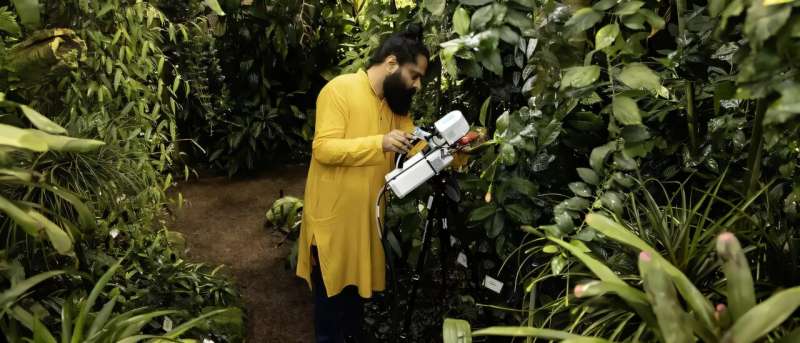

The basis of all life on Earth is photosynthesis. So, what happens if it is disrupted? Today, advanced measurement tools can reveal how climate change is affecting plants’ ability to process the energy from sunlight.
“I want to understand how species and ecosystems can function in the future,” says Rakesh Tiwari, postdoctoral researcher and Birgitta Sintring Fellow at the Department of Ecology and Genetics.
Inside the Tropical Greenhouse rainforest in the botanical garden, moisture drips from enormous tree crowns and giant palm leaves. The contrast with the cold, windy and rainy Uppsala outside could not be greater. Next to a hibiscus bush, Tiwari has set up an advanced instrument that looks like an oblong microscope on a stand. It turns out to be an infrared greenhouse gas analyzer, which is mainly used to measure photosynthesis by manipulating a leaf’s environmental conditions.
“Since it’s a portable instrument, I can take it to different places and analyze photosynthetic response to different environmental conditions for plants. For example, I can change the temperature and light levels, and measure how this affects the photosynthesis rate,” says Tiwari.
He takes a branch and carefully places a hibiscus leaf into the leaf chamber of the instrument. A beam of light is activated and shines through the leaf, mimicking the conditions the plant experiences with extreme heat and solar irradiance. The leaf captures the energy, which then uses carbon dioxide and water to convert it into glucose and oxygen.
The demonstration with the photosynthesis analyzer illustrates the work normally conducted by Tiwari in tropical forests such as those in Puerto Rico.
“These specialized instruments allow us to measure the interaction of light intensity, carbon dioxide concentration in the air, and temperature—parameters that are all crucial for photosynthesis to work. In this way, we can gain deeper insights into how plants might respond to the changing climate.”
Photosynthesis breaks down
What he and other researchers have seen in natural tropical environments is a clear degradation in the efficiency of photosynthesis. During his time at the University of Leeds, Tiwari participated in a research project in 2017 in the Amazon to find out how rising temperatures are threatening the rainforest’s ability to function.
“We used a similar fluorometer to monitor when the photosystems started to break down. What we saw was a clear pattern. Trees in one of the Amazon’s hottest sites are already experiencing air temperature conditions that can affect their photosynthesis machinery.”
In fact, the research team discovered that some plant species were working at the limit of their heat tolerance.
“What was particularly alarming was that during especially hot and dry periods, photosynthesis rates dropped to some of the lowest levels recorded in tropical forests.”
According to Tiwari, the photosynthetic efficiency of a majority of Earth’s plants is down to at most 5%, a huge waste of potential energy. One of the biggest causes of this inefficiency is photorespiration. It is a side reaction that occurs when the enzyme rubisco, responsible for capturing carbon dioxide, binds oxygen instead. How different plant species differ in photorespiration could determine their temperature sensitivity.
“Another factor is the small openings, or stomata, in the plant’s leaves that regulate carbon dioxide absorption and water exchange. In extreme heat, they can close to save water. This is a survival strategy, but it also reduces their photosynthesis rate. While in some trees, stomata open at higher temperatures to make use of evaporative cooling as a leaf cooling mechanism,” Tiwari explains.
The ability to store carbon is declining
It’s been a year since Tiwari came from Leeds to become a postdoc in Bob Muscarella’s research group at Uppsala University. There he investigates the high-temperature strategies of photosynthesis and its mechanisms in forests. Preliminary findings of the research group have shown that the photorespiration temperature sensitivity varies across tropical species.
In the project, Tiwari also looks at how climate change is affecting temperate forests in Sweden, including in collaboration with the Swedish University of Agricultural Sciences in Uppsala.
“The consequences of such understanding can be better informed reforestation projects. For example, we can understand how vegetation could function in warmer futures and how we can adapt our future conservation and afforestation strategies.”
Calling for a conservation perspective
However, it’s not enough to just plant trees, adds Tiwari. The best way to protect the environment is to preserve the natural systems that already exist.
“We cannot recreate the complexity of a mature forest. It does more than just capture carbon; it supports biodiversity, regulates water flows and provides habitats for countless species.”
From 21 October to 1 November, the UN biodiversity conference COP16 is being held in Cali, Colombia. Tiwari hopes the solutions highlighted will focus on sustainability, conservation and long-term thinking.
“If we lose biodiversity and forest ecosystems, we lose the planet’s best natural carbon capture system. One day there may be technologies that can remove carbon dioxide from the atmosphere, but the more we rely on artificial solutions, the more damage we risk causing the planet. These are risks we cannot afford to take.”
Provided by
Uppsala University
Citation:
Photosynthesis is under threat in an increasingly warm world, says researcher (2024, October 21)
retrieved 21 October 2024
from https://phys.org/news/2024-10-photosynthesis-threat-world.html
This document is subject to copyright. Apart from any fair dealing for the purpose of private study or research, no
part may be reproduced without the written permission. The content is provided for information purposes only.